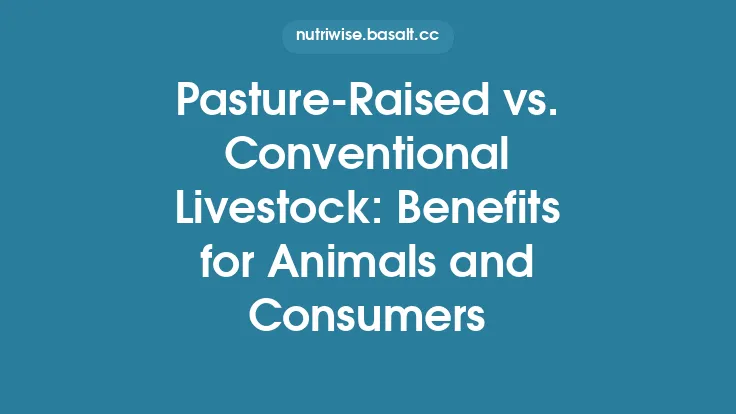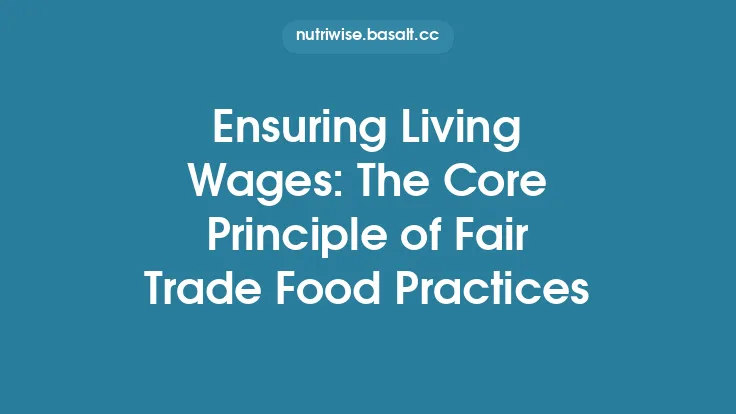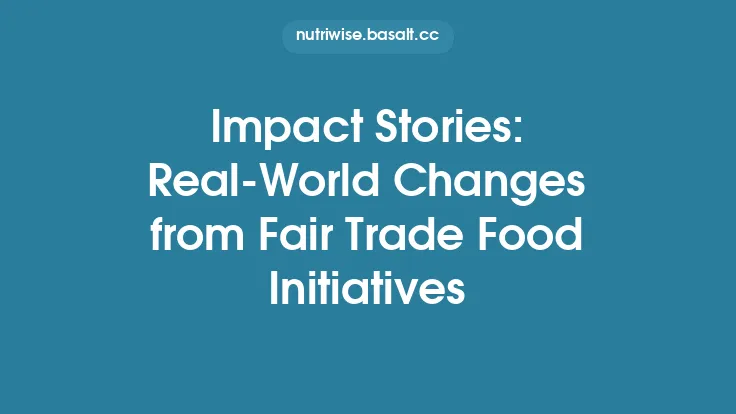Fair Trade and conventional sourcing represent two fundamentally different approaches to bringing food from farm to table. While both aim to deliver products to consumers, the underlying structures, relationships, and long‑term outcomes for the communities that produce those foods diverge sharply. Understanding these differences is essential for anyone who cares about sustainable and ethical eating, not just for the moment of purchase but for the future health, prosperity, and resilience of the people who grow our food.
Economic Foundations of Fair Trade vs. Conventional Sourcing
At the heart of the comparison lies the way producers are compensated. Conventional sourcing typically operates through a series of intermediaries—local collectors, regional traders, exporters, and finally processors or retailers. Each link in the chain adds a margin, often leaving the farmer with a price that barely covers production costs. Prices are also subject to global commodity fluctuations, meaning a sudden drop in market rates can instantly erode a farmer’s income.
Fair Trade, by contrast, establishes a direct price floor that is set above the prevailing market level. This floor is calculated to cover the cost of sustainable production, including a modest surplus for reinvestment. In addition, Fair Trade contracts often include a social premium—a lump‑sum payment that the producer organization can allocate to community projects such as water systems, schools, or health clinics. Because the premium is pooled and decided upon democratically, it tends to be directed toward the most pressing local needs rather than being absorbed by individual profit margins.
The economic distinction is not merely a matter of higher wages; it reshapes the entire financial architecture of a community. By guaranteeing a minimum income and providing a predictable surplus, Fair Trade reduces reliance on volatile market signals and creates a fiscal buffer that can be used for long‑term development.
Community Investment and Infrastructure Development
One of the most visible long‑term benefits of Fair Trade is the systematic reinvestment in community infrastructure. The social premium, which can range from a few hundred to several thousand dollars per hectare depending on the crop and region, is earmarked for projects that improve the collective well‑being of the producer community. Typical investments include:
- Clean water and sanitation facilities: Access to safe drinking water reduces disease incidence and frees up labor—especially women’s labor—that would otherwise be spent on water collection.
- Renewable energy installations: Solar panels and micro‑hydro systems provide reliable electricity for processing, storage, and household use, extending productive hours and reducing reliance on costly diesel generators.
- Transportation improvements: Upgraded roads or community-owned transport fleets lower post‑harvest loss by enabling faster delivery to markets and reducing spoilage.
These infrastructure upgrades have a multiplier effect. For example, a reliable water source not only improves health outcomes but also enables the cultivation of higher‑value crops that require consistent irrigation, thereby further increasing household incomes.
Capacity Building and Skill Transfer
Fair Trade certification often requires producer groups to meet specific standards related to agricultural practices, environmental stewardship, and organizational governance. To achieve and maintain compliance, producers receive training in areas such as:
- Integrated pest management (IPM): Reducing reliance on synthetic chemicals improves soil health and lowers input costs.
- Post‑harvest handling: Proper drying, sorting, and storage techniques preserve quality, allowing producers to command better prices.
- Financial literacy: Understanding budgeting, record‑keeping, and basic accounting empowers farmer cooperatives to manage the social premium effectively.
These capacity‑building initiatives create a knowledge base that persists beyond the certification period. Even if a producer later transitions to a different market channel, the skills acquired under Fair Trade remain valuable, fostering a culture of continuous improvement and innovation.
Health and Nutrition Outcomes for Producer Communities
Higher, more stable incomes enable families to allocate a larger share of their budget to nutritious foods, health services, and preventive care. Empirical studies have shown that communities receiving Fair Trade premiums experience:
- Reduced prevalence of undernutrition: Households can afford a more diverse diet, incorporating protein‑rich legumes, fruits, and vegetables that might otherwise be unaffordable.
- Improved maternal and child health: Access to prenatal care and vaccinations rises when families can cover transportation and service fees.
- Lower incidence of occupational illnesses: Training in safe pesticide handling and the adoption of IPM reduce exposure to harmful chemicals.
These health improvements are not fleeting; they contribute to a healthier labor force capable of sustaining higher productivity over generations.
Education and Youth Opportunities
Education is a cornerstone of long‑term community development. Fair Trade premiums frequently fund the construction of schools, provision of scholarships, and purchase of learning materials. By reducing the financial barrier to schooling, communities see:
- Higher enrollment rates: Children, especially girls, are more likely to attend school when families are not forced to rely on child labor for income.
- Improved literacy and numeracy: Better‑educated youth are equipped to adopt modern agricultural techniques, engage in entrepreneurship, or pursue higher education.
- Reduced rural‑to‑urban migration: When local opportunities expand, young people are less compelled to leave their communities in search of work, preserving social cohesion.
Education creates a virtuous cycle: an educated population can better manage community resources, advocate for their rights, and innovate within the agricultural sector.
Gender and Social Inclusion
While the principle of living wages is a core tenet of Fair Trade, the system also emphasizes participatory decision‑making. Women and marginalized groups often gain a stronger voice in the allocation of the social premium and in the governance of producer organizations. This inclusive approach yields several long‑term benefits:
- Economic empowerment of women: Access to training and leadership roles translates into higher household incomes and greater autonomy.
- Social equity: By ensuring that minority groups are represented in decision‑making bodies, community projects are more likely to address the specific needs of all members, from sanitation facilities for the elderly to childcare services for working parents.
- Enhanced community resilience: Diverse leadership brings a broader range of perspectives, improving problem‑solving capacity during crises such as droughts or market shocks.
Environmental Stewardship and Its Community Ripple Effects
Fair Trade standards require adherence to environmentally responsible practices, which, over time, generate tangible benefits for the surrounding ecosystem and the people who depend on it:
- Soil health preservation: Crop rotation, cover cropping, and reduced chemical inputs maintain soil organic matter, leading to higher yields and reduced erosion.
- Biodiversity conservation: Shade‑grown coffee or cocoa systems provide habitats for native flora and fauna, supporting ecosystem services such as pollination and natural pest control.
- Water resource management: Sustainable irrigation techniques and watershed protection projects safeguard water supplies for both agricultural and domestic use.
Healthy ecosystems reduce the risk of crop failure, lower the cost of inputs, and create a more stable environment for community livelihoods.
Resilience to Market Fluctuations and Climate Shocks
Because Fair Trade establishes a price floor and provides a community premium, producer groups are better insulated from sudden drops in global commodity prices. Moreover, the financial buffer created by the premium can be earmarked for climate‑adaptation measures, such as:
- Drought‑resistant seed varieties: Investing in research and seed banks helps communities maintain production during dry spells.
- Early‑warning systems: Community‑managed weather stations and mobile alert platforms enable farmers to adjust planting schedules proactively.
- Insurance schemes: Some Fair Trade networks facilitate access to low‑cost crop insurance, further reducing vulnerability.
These mechanisms collectively enhance the ability of communities to absorb shocks without resorting to emergency measures that could jeopardize long‑term development.
Intergenerational Benefits and Socioeconomic Mobility
The cumulative effect of stable incomes, improved health, education, and infrastructure creates a foundation for upward socioeconomic mobility that extends across generations. Children raised in Fair Trade‑supported communities are more likely to:
- Attain higher levels of education, opening pathways to diversified employment beyond agriculture.
- Adopt innovative farming practices, increasing productivity and sustainability.
- Participate in civic life, advocating for policies that protect their community’s interests.
Over time, this intergenerational uplift can transform a region from one that is dependent on subsistence agriculture to a vibrant, diversified local economy.
Measuring Long‑Term Impact: Indicators and Methodologies
To assess the enduring benefits of Fair Trade versus conventional sourcing, researchers and development agencies employ a suite of quantitative and qualitative indicators:
| Category | Fair Trade Indicator | Conventional Counterpart |
|---|---|---|
| Economic | Average household income growth rate; proportion of income from social premium | Income volatility index; share of income from market price |
| Health | Incidence of water‑borne diseases; nutrition diversity score | Prevalence of malnutrition; access to health services |
| Education | School enrollment and completion rates; scholarship uptake | Literacy rates; school attendance |
| Infrastructure | Number of community projects funded by premium; access to clean water | Availability of basic services |
| Environmental | Soil organic carbon levels; biodiversity index | Pesticide usage per hectare; deforestation rate |
| Resilience | Adoption of climate‑adaptation practices; insurance coverage | Frequency of crop loss due to climate events |
Longitudinal studies that track these metrics over a decade or more provide the most reliable evidence of sustained impact. Mixed‑methods approaches—combining household surveys, focus groups, and remote sensing data—allow analysts to capture both the statistical trends and the lived experiences of community members.
Concluding Thoughts
Fair Trade and conventional sourcing are not merely different market channels; they embody distinct philosophies about the relationship between producers and consumers. While conventional sourcing often prioritizes efficiency and cost reduction, Fair Trade invests deliberately in the long‑term well‑being of the communities that generate our food. By guaranteeing a price floor, channeling a social premium into community projects, fostering capacity building, and embedding environmental stewardship, Fair Trade creates a virtuous cycle of economic stability, health, education, and resilience.
For consumers who value sustainable and ethical eating, the choice between Fair Trade and conventional products extends far beyond the plate. It is a decision that influences the trajectory of entire communities, shaping their capacity to thrive today and to build a more equitable, resilient future for the generations to come.





